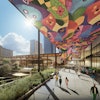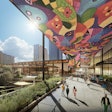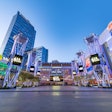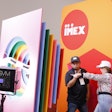Event tech probably will never replace face-to-face meeting. But new technology can drive those interactions to make events more meaningful.
Howard Tullman, CEO of 1871, a tech co-working, incubator and accelerator space housed in Chicago’s Merchandise Mart says in his Inc.
post that it’s about doing research that focuses on the 4 C’s: conditions, circumstances, concerns, and community. The point of that research is about “trying to learn more about the customers’ lives than about their expressed likes and longings.”
That comes through collecting more information to help anticipate, rather than poll, as big (and little) data continue to play an expanding role. To decipher what might happen next, here’s a look at eight important event tech trends for 2018.
Facial recognition for matchmaking
It’s not just the iPhone X. There are plenty of algorithms built to analyze facial features, body language and interpretation. Joe Schwinger, founder of MeetingPlay, a mobile event apps company in Frederick, Maryland, says, “The ability to search a database of faces in real time can speed up check-ins and boost security protocols.”
Houston-based Zenus is paving the way by partnering with event planners. Eventinterface, a conference platform company in Scottsdale, Arizona, partnered with Zenus last year to offer
the world’s first facial recognition event check-in.
Ya-ya Regie did
something similar, partnering with Zenus to be the first U.K. online event registration specialists to try facial recognition for registration and badging during the 2017 ICEAWARDS night at the Saatchi Gallery London.
Chatbots powered by AI
These are two big trends in the industry and they can help with attendee engagement and provide information efficiently and accurately. With Siri and Alexa in our homes, getting a machine to mimic aspects of human behavior—the basis of artificial intelligence—isn’t as farfetched as it once appeared.
Sciensio’s
concierge eventbot allows attendees to text questions and get real time answers. It’s powered by AI, so attendees can access information—think agendas and session information—on any device they’ve got without having to download an app. Meanwhile, planners can easily conduct polls through crowd-sourced questions.
“Chatbots represent the next generation of collecting information,” Schwinger says. MeetingPlay uses voice and text commands, allowing attendees to ask the app questions like “Where is the general session?” and “What time does dinner start tonight?”
Other options include Bots.co, which can help planners quickly build their own app and or get a ready-to-use chat bot and then integrate it with channels like Facebook and Slack. Planners can follow trending information at topbots.com, a site that aggregates content about applied artificial intelligence.
Data collection via RFID
Radio-Frequency Identification is already used for check-in. Even with facial recognition, RFID is still being used frequently to gather real-time detailed data by finding out who is attending an event and to follow-up with attendees after an event.
Boomset provides self-service check-in kiosks and BlueBooking offers tickets, badges or passes that can scanned with a smartphone, wireless barcode scanner or NFC/RFID reader. Cvent’s Alliance Tech has a new RF technology mat that can track attendees as they walk over it the session entrance. There’s also geo-fencing, which happens when you create a virtual perimeter to track attendees via RFID or GPS. Sponsors prefer this so they can target their ads to a particular demographic.
Crowd sourcing via event platforms
Platforms like SharedXP Limited’s crowdsourcing and crowd-voting platform allows planners to create a public or password-protected collaboration webpage that can be emailed to attendees to contribute. The idea is to identify key influencers and cultivate your event community to get pre-registration buy-in.
Vita Mobile Systems, an app company based in Irvine, California, is working with Amazon’s Image Recognition Service to beta test VITA, a crowdsourcing app that uses geolocation and artificial intelligence algorithms. The hope, according to the company’s
website, is to cover everything from reading and analyzing text in photos, to deciphering landscapes and interpreting facial expressions and predicting a person’s mood via pictures and videos.
Gamification with Augmented Reality
In this era of short attention spans, this is one way to get attendees to learn and remain engaged. For example, MeetingPlay designed
AR tokens at Marriott's Corporate Partnership Conference to educate attendees about Marriott's 30 brands following the
Marriott-Starwood merger. Attendees were prompted to hover their app over tokens until a virtual image appeared. Each image provided a clue, similar to a game.
Wearable tech to capture moments
In the world of even tech, wearable devices aren’t anything new. Last year, wearable beacons were popular as a way to alert attendees when they are near networking matches says Schwinger. In 2018, event planners are taking it a step further. They are now measuring event engagement by capturing moments when attendees physiologically react, such as an increase in heart rate, Schwinger says.
Using social media walls
Displaying what is happening via a larger-than-life social media walls is becoming more popular because it shows attendee interactions and gets real-time reactions. The idea is to create a feeling of excitement by using attendee-generated content.
Most walls allow planners to hand-pick content that they can display at their venue. PresentersWall allows attendees to ask questions and give real-time answers using a smartphone, tablet or laptop. Questions can be voted up or down. Tweetwall, Tagboard and Eventifer allow event planners to track hashtags and display images and comments. Tint helps aggregate content. Sprinklr, which was acquired Postano, can source data from 24 channels across 400 metrics and 200 built-in dimensions.
Using low-tech tactics for high-tech results
It sounds basic but many conferences and event planners don’t post enough on
Twitter or create hashtags to use on
Instagram, which is important for tractability.
Planners should make sure their social channels are clearly posted throughout an event. Consider hosting dedicated photo zones with publicly displayed hashtags and your event’s social handles. Regardless of what you do, make sure snapping or tweeting handles are easily accessible.















